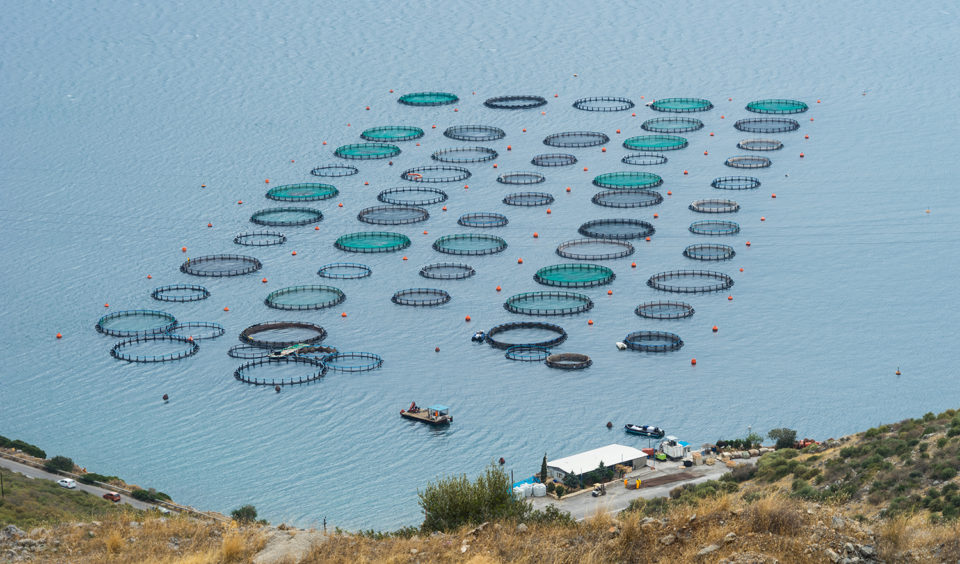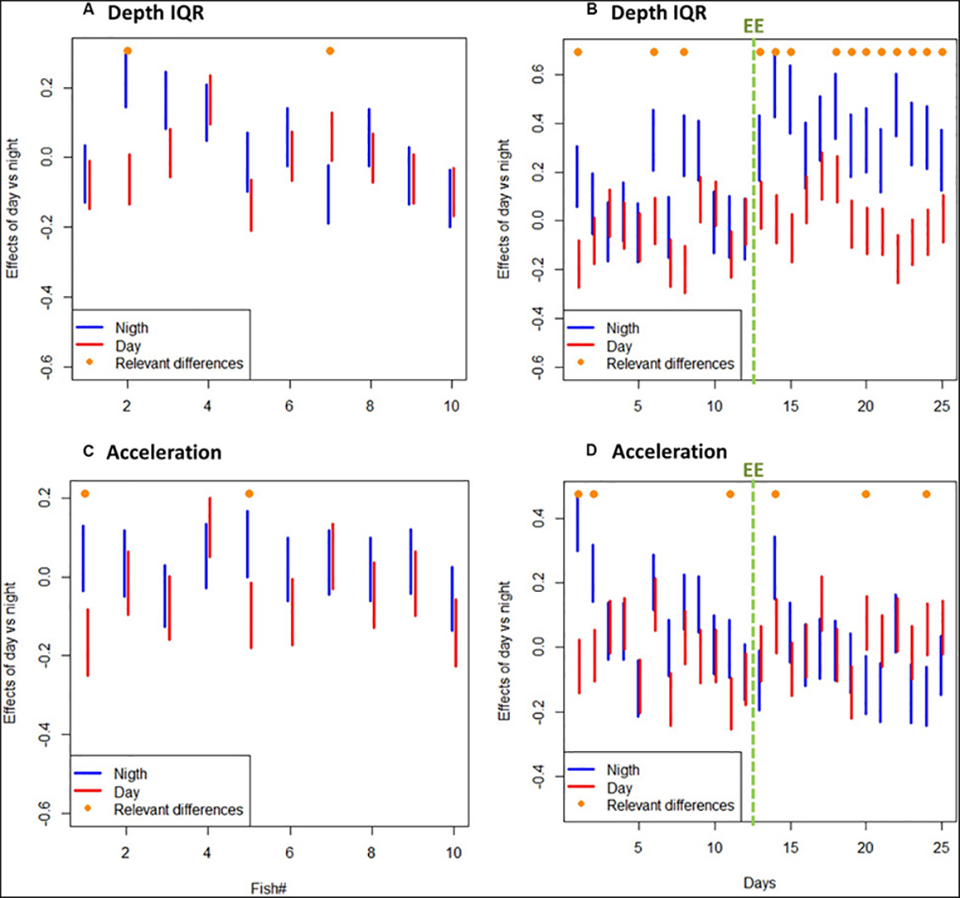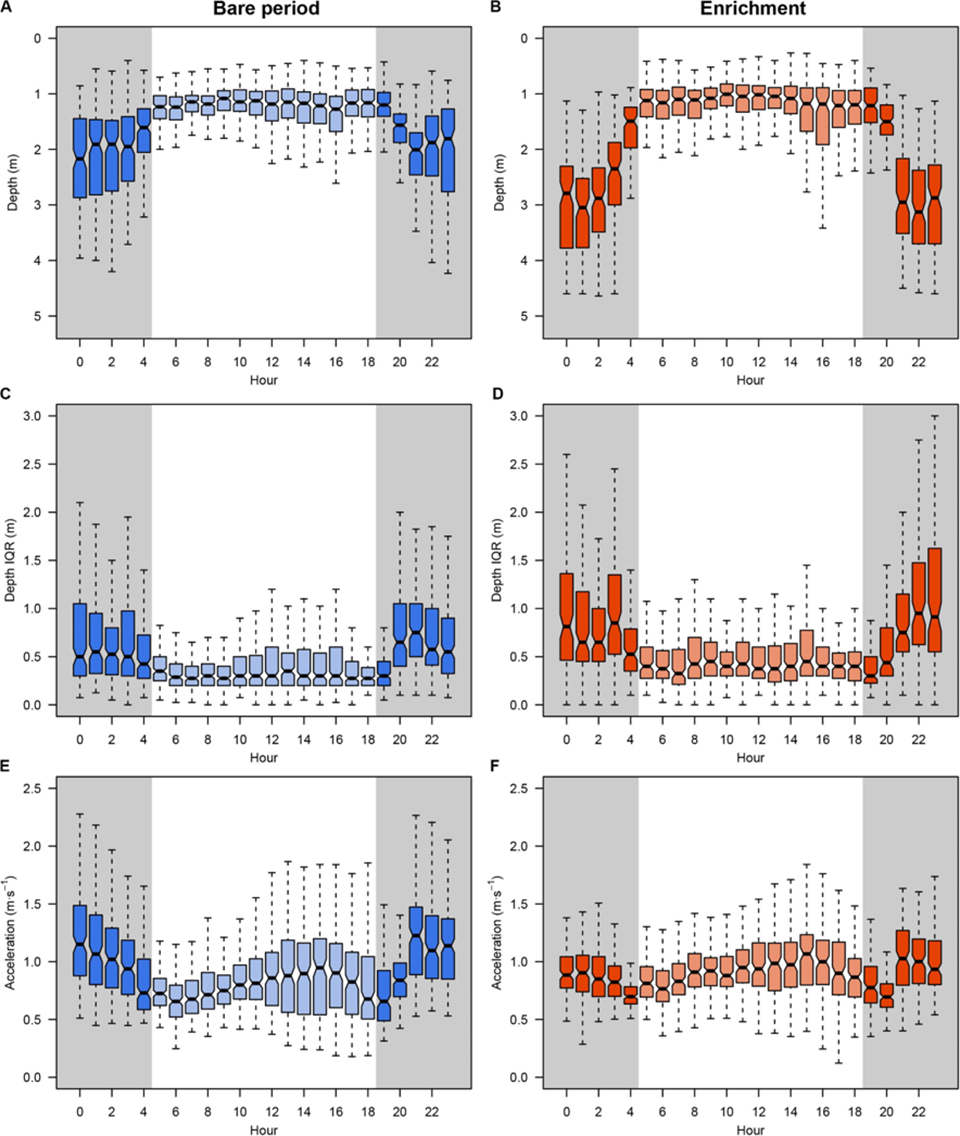Results show clear differences in day, night swimming, vertical distribution patterns

Many fish species are reared in open-sea cages during the last grow-out production stage, where they can experience stressful events by routine farming procedures and conditions, such as transport, crowding, handling, housing, high densities, feeding and environmental stressors.
Common indicators of poor welfare include changes in foraging behavior, ventilatory activity, aggression and stereotypic or abnormal behaviors. Such responses are fast and easy to observe, but they can be variable over time and difficult to quantify. Swimming behavior is a common additional indicator that can be affected by water quality, population densities, feeding regimes and diseases. Therefore, group swimming behavior and spatial distribution may be used as operational on-farm welfare indicators to evaluate hunger, stress level and general health status of fish.
Acoustic telemetry techniques are very useful tools to monitor in detail the swimming behavior and spatial use of the fish in the rearing environment at both individual and group levels. For instance, some acoustic transmitters are equipped with sensors that provide information on the swimming depth, allowing determining the exact position of fish, or even with acceleration sensors, which provide information about swimming activity of the tagged fish. These techniques have been previously used to assess the swimming behavior within cages in various fish species, but not with gilthead sea bream (Sparus aurata).
Fish welfare is an important issue for the industry, not only because of public perception, commercialization and acceptance of products, but also due to the benefits in terms of efficiency, quality and quantity of production. Therefore, it is necessary to develop and introduce new technological systems or tools that allow the correct observation of fish welfare at a commercial scale.
This article – adapted and summarized from the original publication [Muñoz, L,, E. Aspillaga, M. Palmer, J.L. Saraiva and P. Arechavala-Lopez. 2020. Acoustic Telemetry: A Tool to Monitor Fish Swimming Behavior in Sea-Cage Aquaculture. Frontiers in Marine Science 7:645 (doi: 10.3389/fmars.2020.00645)] – evaluated the feasibility of using passive acoustic telemetry techniques in commercial conditions as a potential tool to monitor the welfare of Gilthead seabream juveniles implanted with acoustic transmitters equipped with pressure and acceleration sensors in sea-cage aquaculture.
Study setup
We studied the swimming behavior and distribution of gilthead sea bream in sea cages by using an acoustic telemetry system in an experimental sea cage (a cylindrical-conical net pen, 12.5 meters in diameter, 6 meters deep) located in the coastal waters of Port of Andratx, belonging to the Laboratory of Marine Research and Aquaculture (LIMIA; Mallorca, Balearic Islands, Spain).
A total of 360 sea breams from land-based tanks were used for the experiment, of which 10 sea breams (mean length ± SE: 20.17 ± 1.09 cm; mean weight 217.58 ± 55.96 grams) were tagged with internal “accel-tag” acoustic transmitters (Thelma Biotel Ltd., Trondheim, Norway) equipped with a pressure sensor and a triaxial accelerometer, which provided measurements of the swimming depth (in meters) and the root mean square of the three acceleration axes, respectively.
Precision fish farming: A new framework to improve aquaculture, Part 1
Tagged fish were placed back to the on-land tank together with the rest of the seabream for recovery, which took place in less than 5 minutes. After recovery, all fish (10 tagged fish + 350 untagged fish) were transferred to the experimental sea-cage. After three days of acclimation with no feed, the fish were fed daily throughout the experiment (∼2 percent of body weight) with commercial food pellets (from Skretting) using automatic continuous food dispensers during the day.
The swimming activity (i.e., acceleration) and vertical distribution (i.e., depth) of each fish were monitored by an acoustic receiver array, composed by three receivers positioned around the sea cage, suspended with anchored ropes attached to the floating rings of the cage structure at 5 meters deep, forming a triangle. Data from the receivers was downloaded after completion of the experiment for subsequent analysis
This one-month experiment was divided into separate two-week periods: the “bare period,” without environmental enrichment (EE); and the “enriched period,” where structural EE was added to the cage. Enrichment structures consisted of four vertical ropes (6 meters in length) hanging down into the net-pen with a buoy on top, forming a square in the middle of the cage at about one meter in distance from each other, and attached to the ring by two crossed horizontal ropes.
For detailed information on the experimental design; acoustic telemetry system; experimental sea cage; data management and processing; and statistical analyses used, refer to the original publication.
Results and discussion
The combination of a receiver array and acoustic tags has provided, for the first time, detailed information on the swimming behavior and distribution of gilthead sea bream directly in an experimental sea cage. There was a clear variation in vertical movements and activity, which seems to be influenced by circadian rhythms. It has been shown that farmed gilthead sea bream synchronizes their locomotor activity to both light and feeding phases, two main drivers of circadian rhythms. The natural activity rhythm of this species is diurnal, though fish can change their behavior to nocturnal when fed at night.

Although fish swimming behavior in farming cages has been addressed in many previous studies, this is the first work describing swimming activity (i.e., accelerations), positioning and distribution of gilthead sea bream inside sea cages in such detail. It must be noted that this study was carried out in a single cage, and therefore, it is not possible to evaluate the possible variability between cages (lack of replication), but the behavioral differences between tagged individuals reveal useful information on the behavior of fish under variable conditions.

In our study, adding structural EE did not provoke significant changes in swimming activity, in terms of accelerations, though vertical distribution of tagged fish seemed to be modified. Nevertheless, it should be noted that rearing density in this experiment was lower than in commercial scale cages; given the schooling and social behavior of sea bream, fish distribution and spatial use inside the cage might be different at higher densities.
Estimated error sensitivity for fish positioning in experimental cages resulted in less than 1.5 meters (about 0.7 meters in the center of the cage), which can be enhanced in bigger commercial sea-cages given that the distance between receivers plays an important role on the time of detections arrival. It must be noticed that noise and differences in signal magnitudes may have caused small offsets on registered detection time. Similarly, the high fish densities in commercial sea-cages could have an impact on the transmission conditions in the cage as the fish may attenuate the acoustic signals, but also on the behavior and physiology of seabream.
Our volumetric analysis of 3D positions successfully described the actual space utilized by tagged seabream at low densities, allowing the study of fish distribution within the environment in which they live. The 3D analysis showed that seabream used different areas of the water column during night, and a wider spatial distribution range in presence of structural enrichment (in terms of volume), without increasing the overlap activity space among individuals. It should be noted that fish received the meal automatically and continuously throughout the light period and, not surprisingly, always showed a clear preference for the surface during the day.
Because farmed fish escaping from sea cages represent an economic loss as well as a great problem for wild fish populations, the environmental enrichment might be an alternative to diminish impacts related to escaped fish. Our results highlight the necessity of further studies investigating not only the potential effects of structural EE at commercial scale, but also the swimming behavior and telemetry applications in diverse aquaculture conditions and systems.
This study provides, for the first time, information on swimming activity and distribution of gilthead sea bream inside experimental sea-cages in high detail. The results demonstrated the potential feasibility of using acoustic telemetry for monitoring fish in commercial aquaculture and therefore it might be suggested as a tool for fish farmers to know in detail the specific behavior and distribution of fish in their facilities.
The ongoing technological advances, mostly due to improvements on tag miniaturization, battery life, software and hardware, are rapidly expanding the possibilities of using biotelemetry sensors to accurately assess fish swimming behavior and movements. Electronics tag can be equipped with several kinds of environmental and physiological sensors (e.g., depth, temperature, salinity, acceleration, heart and ventilation rates, muscle activity, etc.), which help to improve the knowledge of different aspects of the fish. For instance, calibrating acoustic transmitters equipped with specific sensors (e.g., accelerometers, electromyograms, heart rate) with fish energy expenditure, will help to better understand the metabolic costs of different activities and to assess what fish do to achieve energetically optimal behavior copying with stress under farming conditions.
In addition, acoustic transmitters allow the wirelessly and real-time transmission of data to the user through hydrophone receivers, as well as real-time monitoring with cabled receivers, which allow fish farmers to monitor and react almost immediately to changes in group behavior (e.g., during feeding) and extending the study period and their feasibility at fish farms. Biotelemetry sensors may also be data storage/archival tags that store data in internal storage mediums that require retrieval of the logger to access the data, limiting their applicability and battery life.
However, all this knowledge is being recently transferred to the aquaculture sector improving the farmer’s ability to monitor, control and document biological processes in fish farms, but further research is still needed before being applied at commercial scale.
Perspectives
Gilthead sea bream is one of the most important fish species for Mediterranean aquaculture, so a better understanding of its circadian rhythms and behavior in grow-out sea cages is of great importance for the industry. With this knowledge, farmers may optimize the routine activities, feeding strategies and space in the farming-cages to improve both the performance and the welfare of their fish – an interesting example where the interest of the industry and the ethical concerns around its activity walk hand in hand.
Consequently, farmers would benefit not only in terms of efficiency, quality and quantity of production, but also regarding the reputation, public perception, marketing and acceptance of products. However, it is necessary to expand the knowledge of the biological requirements for captive fish species and thus determine the optimal conditions for their cultivation.
It is important to continue with this research line, studying the applicability of the acoustic telemetry in the aquaculture industry, optimizing technological monitoring tools and the structures needed for each species and farming condition, to help improving welfare status of fish in captivity.
References available in the original publication.
Now that you've finished reading the article ...
… we hope you’ll consider supporting our mission to document the evolution of the global aquaculture industry and share our vast network of contributors’ expansive knowledge every week.
By becoming a Global Seafood Alliance member, you’re ensuring that all of the pre-competitive work we do through member benefits, resources and events can continue. Individual membership costs just $50 a year. GSA individual and corporate members receive complimentary access to a series of GOAL virtual events beginning in April. Join now.
Not a GSA member? Join us.
Authors
-
Lidia Muñoz
Fish Ecology Group
Instituto Mediterráneo de Estudios Avanzados (IMEDEA-CSIC/UIB)
Mallorca, Spain -
Eneko Aspillaga
Fish Ecology Group
Instituto Mediterráneo de Estudios Avanzados (IMEDEA-CSIC/UIB)
Mallorca, Spain -
Miquel Palmer, Ph.D.
Fish Ecology Group
Instituto Mediterráneo de Estudios Avanzados (IMEDEA-CSIC/UIB)
Mallorca, Spain -
João L. Saraiva, Ph.D.
Fish Ethology and Welfare Group
Centro de Ciências do Mar (CCMAR)
Faro, Portugal -
Pablo Arechavala-Lopez, Ph.D.
Corresponding author
Fish Ecology Group
Instituto Mediterráneo de Estudios Avanzados (IMEDEA-CSIC/UIB)
Mallorca, Spain; and
Fish Ethology and Welfare Group
Centro de Ciências do Mar (CCMAR)
Faro, Portugal[116,101,110,46,104,115,105,102,45,114,105,97,102,64,111,108,98,97,112]
Tagged With
Related Posts

Responsibility
Precision fish farming: A new framework to improve aquaculture, Part 1
A review of technology usage in finfish aquaculture, future application possibilities for precision fish farming (PFF) and guidelines for research.

Innovation & Investment
Mixed-cell raceways offer best of two water worlds
One solution to the problems with raceways is to convert them into a series of counter-rotating mixed cells that act as hydraulically separated round tanks.

Intelligence
Notes from the 15th North Atlantic Seafood Forum
C-level seafood executives from around the world gathered at the North Atlantic Seafood Forum to discuss pressing issues facing fisheries and aquaculture.

Innovation & Investment
Rise of the machines: Aquaculture’s robotic revolution
Technological advances are revolutionizing aquaculture. From airborne inspection tools to underwater drones, innovative robotics and automation technology are unveiling a brave new world of futuristic farming.


